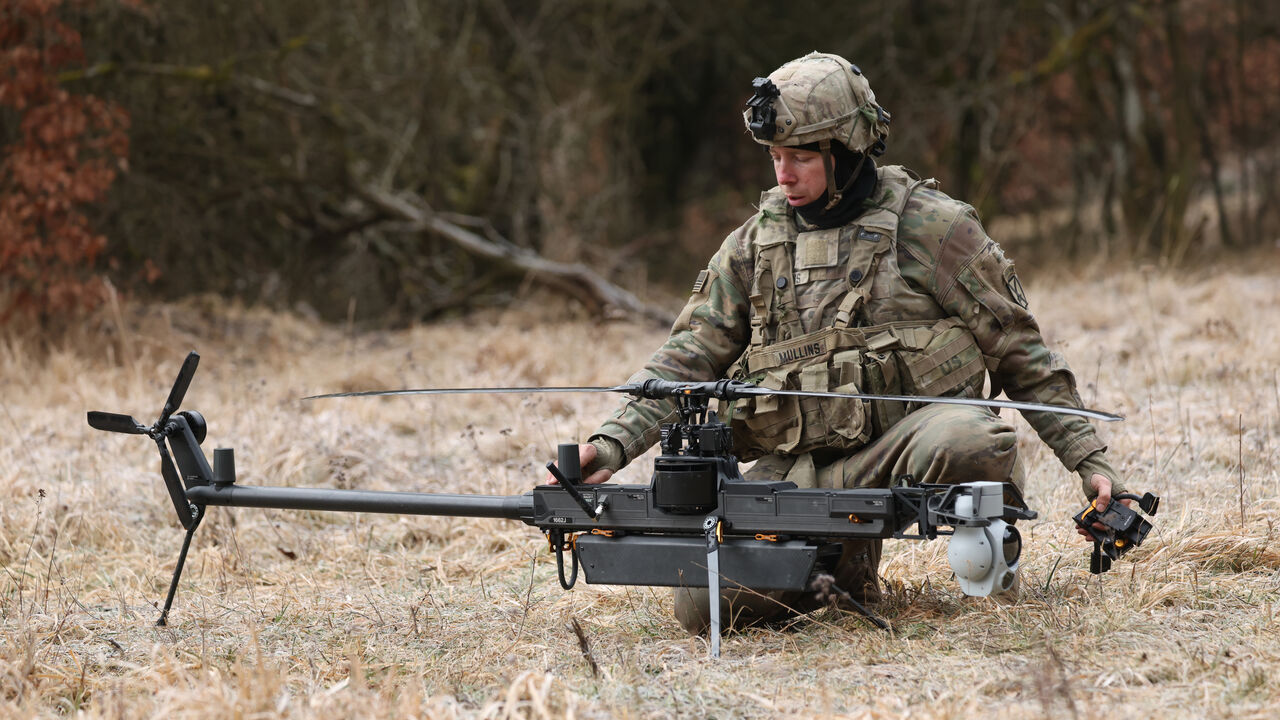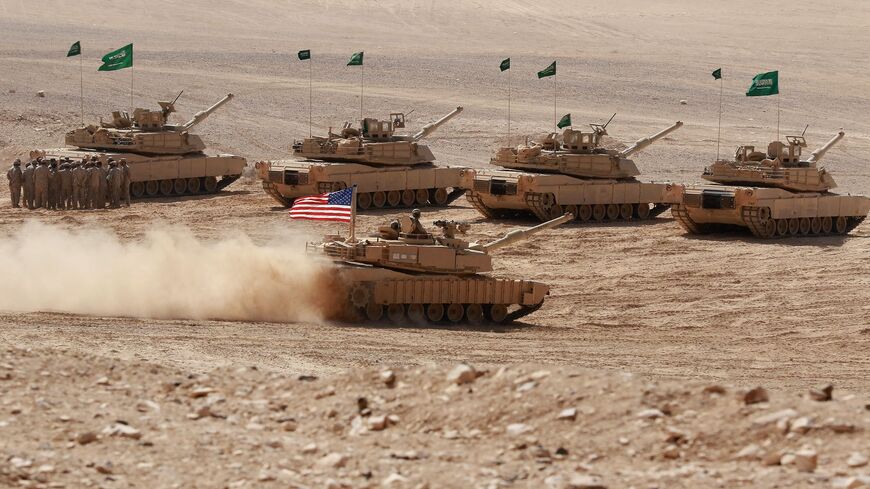CENTCOM launches task force to drive Pentagon’s drone race
New unit aims to put "combat-credible" drone systems into the hands of US troops in the Middle East within 60 days, part of an ambitious new push by the Pentagon to leapfrog advances made by Washington's adversaries in fielding cheaply made but lethal armed drones.

WASHINGTON — The US military’s regional command headquarters for the Middle East formed a new team tasked with getting small armed drones into the hands of American military personnel in the region.
The announcement on Tuesday by US Central Command comes as the Pentagon aims to keep up with advances by adversaries Russia and Iran in deploying cheaply made drone weaponry on the battlefield.
“This is about getting new warfighting capabilities into the hands of our skilled warfighters faster,” CENTCOM’s commander, four-star US Navy Adm. Brad Cooper, said in a statement. It went on, “The new task force will synergize existing efforts among our service components and support Secretary Hegseth’s drive to rapidly equip our warriors.”
Why it matters: The Pentagon under Pete Hegseth has set ambitious new deadlines to catch up with advances made by Washington’s adversaries in fielding large numbers of cheaply made armed drones.
Small but lethal drones widely deployed at the squad and platoon level during Russia’s war in Ukraine have proven decisive in halting major advances and crippling the Kremlin’s Black Sea fleet, prompting the Pentagon to rethink fundamental tactics of land and naval warfare.
In a new policy outlined in a June 10 memo, Hegseth said the department’s “bureaucratic gloves are coming off” in a new effort to “leapfrog” US adversaries’ by approving the purchase of “hundreds” of new US-made systems including “low-cost” armed drones and getting them into the hands of troops.
In August, Hegseth ordered the dissolution of the Pentagon’s main office for developing counter-drone weapons systems and had Army Secretary Dan Driscoll replace it with a new interagency task force answerable to Deputy Defense Secretary Stephen Feinberg.
Top brass at US CENTCOM have sought to push their units to the forefront of field experimentation with armed drone and counter-drone systems in the Middle East as the decisive implications of such systems have grown increasingly difficult to ignore.
Part of CENTCOM’s innovation effort has been born of necessity, given the persistent exposure of American troops in the region to cheap but deadly Iranian-made attack drones. But it is also a way for top commanders to retain access and influence within the Pentagon’s bureaucracy as the Middle East continues to be deprioritized while Washington shifts its strategic focus to the Asia-Pacific region.
The new task force announced on Tuesday, dubbed the Rapid Employment Joint Task Force, is set to be headed by Joy Shanaberger, CENTCOM’s chief technology officer.
“Our goal is to rapidly deliver innovation, meaning putting combat-credible capability into the hands of our warfighters in 60 days or less,” Shanaberger said in the statement released this week by CENTCOM.
Shanaberger, who took over after the command’s inaugural CTO Schuyler Moore departed late last year, previously served as a top adviser to the Pentagon’s second-highest official during the Biden administration, former Deputy Secretary of Defense Kathleen Hicks.
Hicks’ office spearheaded the Pentagon’s Replicator initiative, which aimed to field thousands of “attritable” AI-linked drones by August 2025, part of what officials characterized as the Pentagon's flagship effort to deter China’s military advances in the Pacific. Yet officials have revealed few details about Replicator's progress.
The context: Top officials at CENTCOM are remembering the lessons learned from their forces’ exposure to years of Iran-linked drone attacks into field testing that the Pentagon can in turn apply toward developing tactics to defend Taiwan and the Western Pacific’s so-called first island chain from any future aggression by Beijing.
An unclassified annual Pentagon assessment released in December 2024 found that China’s advances in drone technology were quickly approaching US capabilities.
Last week, US and Saudi military personnel completed their fourth experimental drone air-defense exercise at the Shamal-2 range in the kingdom’s northeast, having fielded 20 counter-drone systems in what Cooper described as an effort to identify “best-in-breed” weapons systems.
The latest "Red Sands" exercise saw US and Saudi forces field a broad medley of new and traditional systems — everything from body-worn radio frequency sensors; MLIDS, Skyguard and Shikra ground-based counter-drone interceptors; AH-64 Apache helicopters, F-15s, Typhoon and AC-130 aircraft; and "drone defeat rounds" fired by soldiers from a 12-gauge shotgun.
Combined air defense efforts by the US, Israel and other allies have proven effective in thwarting major Iranian drone and missile attacks in the region before. But Pentagon planners have long seen the financial cost offset of scrambling F-16s and F-15s to shoot down small fiberglass Iranian-made Shahed-131s in air-to-air combat as an unsustainable long-term strategy.
What’s next: Under the new policy announced by Hegseth in June, the Pentagon wants “every squad” in the US military to be equipped with cheap, expendable drones by the end of 2026, with priority going to units in the Indo-Pacific region. The new policy also aims for all major US military exercises to incorporate drones by 2027.
“Our adversaries collectively produce millions of cheap drones each year,” Hegseth’s June 10 policy memo read. “Modern battlefield innovation demands a new procurement strategy that fuses manufacturers with our frontline troops,” it continued.
Know more: The Trump administration further relaxed the US government’s interpretation of the 35-nation agreement limiting exports of armed missile and drone technology, known as the Missile Technology Control Regime, earlier this month.
The decision aims to give Washington a leg up in foreign markets for armed drone sales over China, Turkey and Iran, which have dominated the region’s armed drone market in recent years.
The latest moves out of Washington are part of broader reform efforts within the Pentagon and on Capitol Hill to speed up the US’ backlogged foreign arms sales process in a bid to regain Washington’s flagging influence.
"Ultimately, for the United States to remain the partner of choice, not just in the Middle East but worldwide, it must continue to balance between meeting market demand and protecting its proprietary technologies," wrote Grant Rumley and Elizabeth Dent, two former Pentagon policy officials focused on the region, in an op-ed published by Defense News last week.
"Providing the US the ability to simply compete with China in UAV sales is not, in itself, a strategy," they argued.





